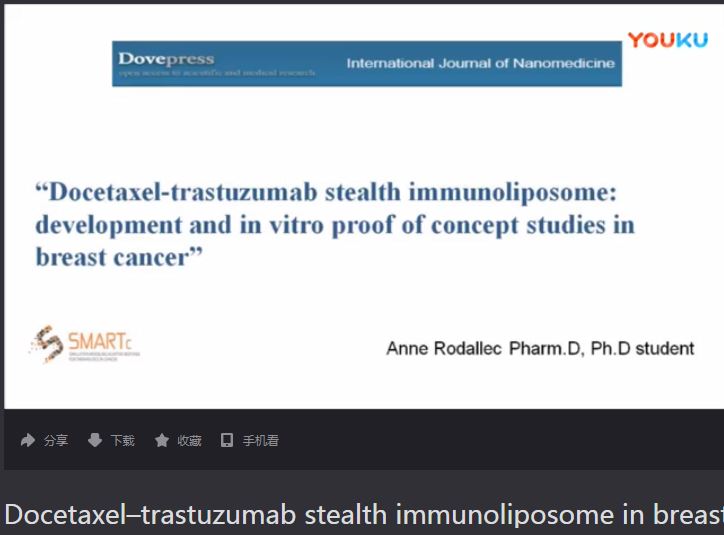9 0 6 7 6
论文已发表
注册即可获取德孚的最新动态
IF 收录期刊
- 2.6 Breast Cancer (Dove Med Press)
- 3.9 Clin Epidemiol
- 3.3 Cancer Manag Res
- 3.9 Infect Drug Resist
- 3.6 Clin Interv Aging
- 4.8 Drug Des Dev Ther
- 2.8 Int J Chronic Obstr
- 8.0 Int J Nanomed
- 2.3 Int J Women's Health
- 3.2 Neuropsych Dis Treat
- 4.0 OncoTargets Ther
- 2.2 Patient Prefer Adher
- 2.8 Ther Clin Risk Manag
- 2.7 J Pain Res
- 3.3 Diabet Metab Synd Ob
- 4.3 Psychol Res Behav Ma
- 3.4 Nat Sci Sleep
- 1.9 Pharmgenomics Pers Med
- 3.5 Risk Manag Healthc Policy
- 4.5 J Inflamm Res
- 2.3 Int J Gen Med
- 4.1 J Hepatocell Carcinoma
- 3.2 J Asthma Allergy
- 2.3 Clin Cosmet Investig Dermatol
- 3.3 J Multidiscip Healthc

Docetaxel-trastuzumab stealth immunoliposome: development and in vitro proof of concept studies in breast cancer
Authors Rodallec A, Brunel JM, Giacometti S, Maccario H, Correard F, Mas E, Orneto C, Savina A, Bouquet F, Lacarelle B, Ciccolini J, Fanciullino R
Received 13 January 2018
Accepted for publication 24 February 2018
Published 18 June 2018 Volume 2018:13 Pages 3451—3465
DOI https://doi.org/10.2147/IJN.S162454
Checked for plagiarism Yes
Review by Single-blind
Peer reviewers approved by Dr Cristina Weinberg
Peer reviewer comments 3
Editor who approved publication: Prof. Dr. Thomas J Webster
Background: Trastuzumab plus docetaxel is a mainstay to treat HER2-positive
breast cancers. However, developing nanoparticles
could help to improve the efficacy/toxicity balance of this doublet by
improving drug trafficking and delivery to tumors. This project aimed to
develop an immunoliposome in breast cancer, combining docetaxel encapsulated in
a stealth liposome engrafted with trastuzumab, and comparing its performances
on human breast cancer cell lines with standard combination of docetaxel plus
trastuzumab.
Methods: Several strategies to engraft trastuzumab to
pegylated liposomes were tested. Immunoliposomes made of natural (antibody
nanoconjugate-1 [ANC-1]) and synthetic lipids (ANC-2) were synthesized using
standard thin film method and compared in size, morphology, docetaxel
encapsulation, trastuzumab engraftment rates and stability. Antiproliferative
activity was tested on human breast cancer models ranging from almost negative
(MDA-MB-231), positive (MDA-MB-453) to overexpressing (SKBR3) HER2. Finally,
cell uptake of ANC-1 was studied by electronic microscopy.
Results: ANC-1 showed a greater docetaxel encapsulation
rate (73%±6% vs 53%±4%) and longer stability (up to 1 week) as compared with
ANC-2. Both ANC presented particle size ≤150 nm and showed similar or higher in
vitro antiproliferative activities than standard treatment, ANC-1 performing
better than ANC-2. The IC50s for
docetaxel combined to free trastuzumab were 8.7±4, 2±0.7 and 6±2 nM with
MDA-MB-231, MDA-MB-453 and SKBR3, respectively. The IC50s for ANC-1 were 2.5±1, 1.8±0.6 and 3.4±0.8 nM
and for ANC-2 were 1.8±0.3 nM, 2.8±0.8 nM and 6.8±1.8 nM with MDA-MB-231,
MDA-MB-453 and SKBR3, respectively. Cellular uptake appeared to depend on HER2
expression, the higher the expression, the higher the uptake.
Conclusion: In vitro results suggest that higher antiproliferative
efficacy and efficient drug delivery can be achieved in breast cancer models
using nanoparticles.
Keywords: immunoliposomes,
biopharmaceutical development, breast cancer, docetaxel, trastuzumab, HER2
摘要视频链接:Docetaxel–trastuzumab stealth immunoliposome in breast cancer
